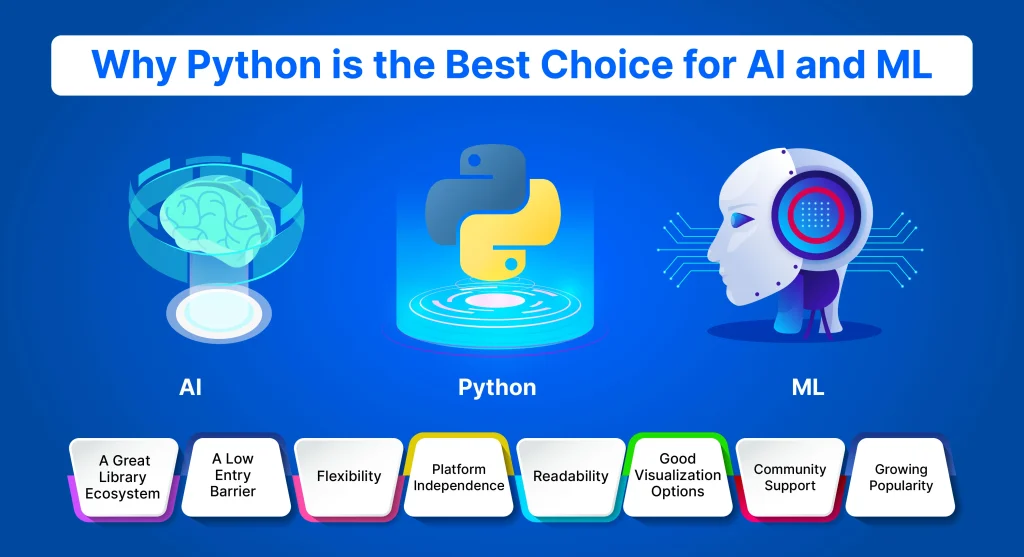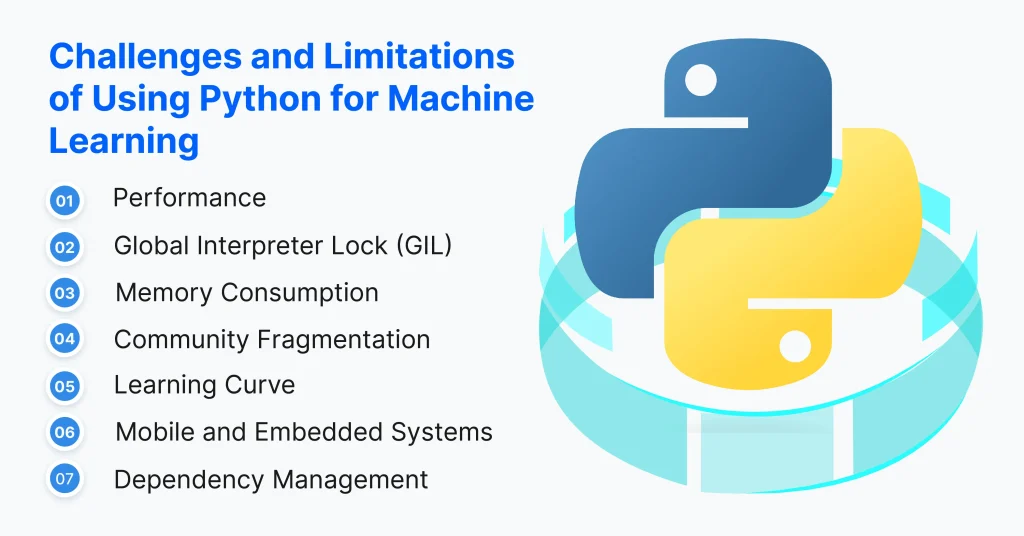How AI and ML Form Technologies of The Future
Modern data processing and analysis employ AI and ML due to the growing volumes and complexity of data. The human brain can analyze a lot of data, to be fair, but its capacity to do so is constrained by the amount of data it can process at any given time. Artificial intelligence is not constrained by this. AI provides more precise forecasts and insights that boost productivity, reduce costs associated with production, and enhance corporate efficiency. It makes sense that a wide range of sectors use AI and ML to boost productivity and advance product development. Artificial intelligence with Python unlocks a world of possibilities to create advanced and intelligent systems.
AI-powered businesses are the newest development in the technological revolution intended to increase efficiency, according to Deloitte research. This is further supported by their projection that, in the next 24 months, a growing number of businesses would likely employ AI in their processes and products to boost efficiency and accomplish strategic objectives. In summary, artificial intelligence facilitates better work with less effort.
It’s important to adopt artificial intelligence programming language that lowers code complexity and facilitates simple implementation as more businesses create AI-based products. These days, machine learning (ML) with Python, data science, and artificial intelligence (AI) are highly valued. Why? because it has a huge number of libraries, is versatile, provides tools that are both flexible and easy to use, and has a large community of Python developers.
Artificial Intelligence (AI) and Machine Learning (ML) stand at the forefront of technological evolution, shaping the future in ways once deemed unimaginable. As we navigate the complexities of the digital era, these twin technologies are not just tools but transformative forces, revolutionizing industries and redefining our daily lives.
Python for AI and ML: The Best Programming Language
As of October 2022, Python surpassed Java and C as the most popular languages, according to the TIOBE Index Large companies are investing in AI and ML as they are being deployed across a wide range of channels and industries, which is driving up demand for ML and AI professionals. Based on indeed.com trend search results, Jean Francois Puget, of IBM’s machine learning division, stated that he believes Python to be the most often used language for AI and ML. Discover the boundless opportunities that arise from combining AI with Python, facilitating the development of cutting-edge solutions that redefine the possibilities in the world of artificial intelligence.
In the era of Artificial Intelligence (AI) and Machine Learning in Python has emerged as the indisputable champion, earning its status as the go-to programming language for developers and data scientists alike. Its versatility, simplicity, and robust ecosystem make it the best-suited language to harness the power of intelligent technologies.
Python’s clean and readable syntax is a standout feature, making it an ideal language for AI and ML projects. Its resemblance to the English language simplifies code comprehension, easing the learning curve for both beginners and experienced developers.

1. A Great Library Ecosystem
Python’s dominance in AI and ML is fueled by its extensive library ecosystem. Python AI libraries such as TensorFlow, PyTorch, and scikit-learn offer a wealth of pre-built functions and modules, streamlining complex tasks. TensorFlow, developed by Google, is renowned for its efficiency in building and training neural networks. PyTorch, favored for its dynamic computational graph, enhances flexibility in model development. Meanwhile, scikit-learn simplifies machine learning algorithms, making them accessible to developers of varying expertise. The rich library ecosystem not only accelerates development but also encourages collaboration within the AI and ML community, contributing to continuous innovation.
2. A Low Entry Barrier
Python’s popularity in AI and ML is partly attributed to its low entry barrier. Its straightforward syntax, resembling the English language, makes it easily understandable for both beginners and experienced developers. This simplicity accelerates the learning curve, allowing individuals to quickly grasp the fundamentals of programming and dive into AI and ML projects. The reduced complexity in coding fosters a welcoming environment for newcomers, democratizing access to the world of intelligent technologies. Python’s low entry barrier has been a catalyst in expanding the community of AI and ML enthusiasts, nurturing a diverse range of perspectives and ideas.
3. Flexibility
Working in the machine learning and artificial intelligence fields requires handling large amounts of data that must be processed efficiently. Because Python has a low learning curve, more data scientists can pick it up fast and use it for AI development without having to invest a lot of time or energy in learning the language. Dive into the world of AI with Python as your language of choice.
The Python programming language bears similarities to everyday English, which facilitates learning. Its straightforward syntax makes working with complicated systems easy and guarantees that system pieces are related to one another. Because simplicity is key, using Python for AI is justifiable.
Python’s inherent flexibility contributes significantly to its prominence in AI and ML. Its versatile nature allows developers to seamlessly integrate Python with other languages and frameworks, enhancing the adaptability of AI solutions across diverse environments. The language accommodates both object-oriented and procedural programming paradigms, providing developers with the freedom to choose the approach that best suits their project requirements. This flexibility extends to deployment, enabling easy integration with web applications, cloud services, and mobile platforms. Python’s adaptability not only streamlines development processes but also positions it as an ideal language for tackling the evolving challenges and opportunities in the dynamic landscape of AI and ML.
Furthermore, flexibility enables developers to select programming languages with which they are completely at ease or even to combine languages to find the most effective solution for a variety of problems.
- The imperative style is made up of orders along with instructions on how the machine is to carry them out. This method allows you to specify the series of calculations that take place when the program state changes.
- Because the functional style specifies what actions should be carried out, it is also known as the declarative style. Unlike the imperative style, it declares statements in the form of mathematical equations and does not take the program state into account.
- Two ideas underpin object-oriented programming: classes and objects, which are groups of related objects.
4. Platform Independence
Python’s platform independence is a key attribute that enhances its appeal for AI and ML development. Whether running on Windows, macOS, or Linux, Python provides a consistent and seamless experience. This platform-agnostic nature simplifies deployment across diverse environments, ensuring that AI and ML solutions developed in Python can effortlessly transition between different operating systems, contributing to the language’s versatility and widespread adoption.
Platform independence is Python’s next benefit for AI and ML development. Python is incredibly versatile in addition to being easy to learn and comfortable to use. In other words, Python is compatible with twenty-one different platforms, including Windows, MacOS, Linux, and Unix, and may be used for machine learning research on any of them. To move the process from one platform to another, engineers must make a few minor adjustments and update a few lines of code to turn the code into an executable format for the target platform. Packages such as PyInstaller help developers get their programs ready to operate on many platforms.
5. Readability
The readability of Python code is a standout feature, solidifying its position as a preferred language for AI and ML. Python’s syntax, designed for clarity and simplicity, mirrors the English language, making the code easily understandable. This readability not only accelerates the development process but also facilitates collaboration among team members. In AI and ML projects where complex algorithms and models are common, Python’s readability becomes a powerful asset, allowing developers and data scientists to comprehend and modify code with ease.
6. Good Visualization Options
Effective visualization is crucial in AI and ML to interpret complex data and model outputs. Python excels in this aspect with a myriad of visualization libraries, such as Matplotlib, Seaborn, and Plotly. These libraries provide diverse and customizable options for creating charts, graphs, and interactive visualizations. The availability of these tools empowers developers and data scientists to communicate findings more effectively, aiding in the interpretation of results and enhancing the overall understanding of complex AI and ML models.
7. Community Support
Python’s robust community support is a driving force behind its success in AI and ML. The expansive and engaged community ensures that developers have access to a wealth of resources, including forums, tutorials, and documentation. This collaborative environment facilitates knowledge-sharing, problem-solving, and the exchange of best practices. In the dynamic field of AI and ML, having a supportive community is invaluable, as it accelerates learning, fosters innovation, and provides a strong foundation for developers to tackle challenges effectively. Python’s vast community contributes to its strength, fostering collaboration, innovation, and a wealth of shared knowledge among developers worldwide.
8. Growing Popularity
Python’s growing popularity is evident in its increasing adoption across industries. As AI and ML applications become integral to various sectors, Python’s versatility and ease of use have contributed to its widespread recognition. The language’s popularity not only attracts seasoned developers but also encourages newcomers to explore AI and ML. The growing community, coupled with the language’s adaptability to emerging technologies, positions Python as a cornerstone in the ever-expanding landscape of intelligent technologies.
Python is getting more and more popular among data scientists due to the benefits outlined above. StackOverflow projects that Python will continue to gain popularity through at least 2020.
This makes it simpler to find developers and, if necessary, swap out team participants. Additionally, their labor might not be as expensive as it would be if they were to use a less common programming language.
Python Use Cases for AI and ML
Let’s now examine the applications of Python in machine learning and artificial intelligence.
Python has established itself as the quintessential AI development language, chosen for its readability, extensive libraries, and vibrant community support. Python is the greatest language for these uses since it has a lot of features that are especially beneficial for AI and ML. It makes sense that Python is used by many businesses for machine learning tasks such as prediction. AI with Python is a synergy that propels your projects to new heights.

Let’s examine a few instances in more detail:
Travel
Python is instrumental in the travel industry, where AI and ML research transforms operations. From optimizing itineraries to predicting demand and offering personalized recommendations, Python-driven algorithms analyze extensive datasets. Research in this field involves studying travel trends, enhancing pricing strategies, and refining customer experiences. Python facilitates the integration of cutting-edge technologies, allowing for the development of advanced models that contribute to the evolution of travel services. The language’s adaptability and rich ecosystem of libraries provide a foundation for continual research, driving innovation and efficiency in the travel sector.
Fintech
In fintech, Python’s role in AI and ML is underpinned by ongoing research in fraud detection, credit scoring, and algorithmic trading. Python empowers researchers and developers to experiment with new approaches, facilitating continuous advancements in financial services. The language’s simplicity expedites the research process, enabling fintech companies to stay at the forefront of innovation. Ongoing research in Python-centric fintech applications focuses on refining predictive models, enhancing risk management, and improving fraud prevention mechanisms, ensuring the industry remains agile and resilient. By 2030, it’s estimated that AI in fintech may save operating costs by 22%, yielding an astounding $1 trillion in savings.
Transportation
Python serves as the engine for research-driven AI and ML applications in transportation. Ongoing research explores ways to optimize route planning, predict maintenance requirements, and improve logistics efficiency. Machine learning algorithms, powered by Python, delve into vast datasets, studying traffic patterns and historical information to provide real-time insights. Continuous research in Python contributes to the development of intelligent transportation solutions, propelling advancements in autonomous vehicles, predictive maintenance, and sustainable urban mobility.
Healthcare
Python’s impact on healthcare is driven by continuous research in AI and ML applications. Research efforts focus on disease diagnosis, drug discovery, and personalized treatment plans. Python’s flexible and extensive libraries enable the development of cutting-edge models for medical image analysis and patient outcome predictions. Frameworks like TensorFlow and PyTorch, backed by ongoing research, facilitate deep learning in healthcare. Python’s accessibility ensures that the latest research findings can be readily applied, fostering innovation and improvements in medical research and patient care outcomes.
Challenges and Limitations of Using Python for Machine Learning
While Python is widely embraced in the machine learning (ML) community, it does come with its set of challenges and limitations:

Performance
Python is known for being flexible and easy to use, but it might not perform as quickly as other languages like Java or C++. This could be an issue for some machine learning applications, especially those that require a lot of processing, like deep learning. It’s crucial to remember that there are a number of ways to improve Python’s performance, including just-in-time compilation and parallelization.
Apart from its slower speed, memory utilization, and method complexity are other variables that can affect Python’s performance. For instance, to guarantee successful navigation when building self-driving cars with Python, the amount of memory utilized to keep the most current speed, distance traveled, speed limit, and other relevant data about moving cars must be limited.
Python’s interpreted nature can lead to performance issues, particularly in computationally intensive tasks. Although libraries like NumPy and TensorFlow partially address this, languages like C++ or Java may be preferred for certain performance-critical applications.
Global Interpreter Lock (GIL)
Python’s Global Interpreter Lock can hinder the execution of multiple threads simultaneously, impacting the parallel processing capabilities crucial for certain ML tasks. This limitation may affect the scalability of Python applications in multi-core environments.
Memory Consumption
Python may not be as memory-efficient as languages like C or C++. For large-scale ML projects dealing with extensive datasets, this can lead to increased memory consumption, potentially limiting the size of datasets that can be processed.
Community Fragmentation
The ML community is diverse, with researchers and practitioners using different tools and libraries. This diversity can lead to fragmentation, making it challenging for developers to choose the best libraries and tools for their specific needs.
Learning Curve
Python’s simplicity is an advantage, but for individuals new to programming or machine learning, the vast array of libraries and frameworks can create a steep learning curve. This might be a limitation for those looking for a quick entry into ML.
Mobile and Embedded Systems
Python may not be the first choice for ML applications in resource-constrained environments like mobile devices or embedded systems. The language’s overhead may be impractical for certain real-time or edge computing scenarios.
Dependency Management
Managing dependencies and ensuring compatibility between different libraries and versions can be challenging. This can lead to issues when integrating various components of a machine-learning pipeline.
Despite these challenges, Python’s extensive libraries (e.g., TensorFlow, PyTorch, scikit-learn) and active community support make it a versatile and widely used language for machine learning. Understanding these limitations allows practitioners to make informed decisions based on the specific requirements of their ML projects.
Start your AI/ML Development Services with IntellicoWorks
Elevate your projects with cutting-edge AI/ML development services by connecting with IntellicoWorks. Specializing in crafting intelligent solutions, IntellicoWorks brings a wealth of expertise to propel your business into the future. Harness the power of artificial intelligence and machine learning to gain valuable insights, enhance user experiences, and optimize operations.
IntellicoWorks stands out as a trusted partner, offering tailored AI/ML development services that cater to your unique needs. From conceptualization to implementation, their skilled team ensures seamless integration of advanced algorithms and models. Start your machine learning with Python, utilizing its extensive libraries and user-friendly syntax to seamlessly develop intelligent models and solutions.
Stay ahead in the dynamic landscape of technology with IntellicoWorks’ unparalleled AI/ML expertise. Contact them today to embark on a transformative journey, unlocking the full potential of artificial intelligence for your business success.
Summing It Up
In conclusion, because of its vast libraries and frameworks, cross-platform compatibility, and simple syntax, Python has become a popular programming language in the field of machine learning. Because of its flexibility and adaptability, developers can use it to solve a variety of challenging machine learning problems, such as speech and picture recognition, predictive analytics, and autonomous cars. Even if Python has its drawbacks and difficulties, anyone can become proficient in the language and realize Python’s full potential in the field of machine learning with the correct tools and commitment. start your projects to new heights with specialized AI development services, harnessing the transformative power of artificial intelligence.
So, the question “Why is Python popular?” can be answered by highlighting its extensive libraries and simplicity. Start a journey of innovation as you explore the synergy between AI and Python, harnessing the language’s simplicity, extensive libraries, and community support to propel your projects to new heights.
Empower Your Business With Our
Cutting-edge AI Solutions!


